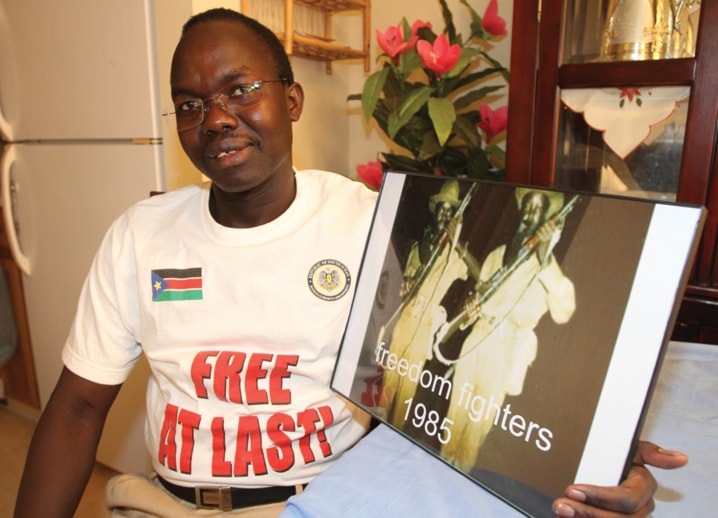On the living room wall is a photo of two young soldiers holding rifles in high port position.
It’s pitch black outside. They wear khaki fatigues and wide brimmed hats. They appear strong. They’re not smiling.
Monybany Mingyang Dau is the boy on the left. The rifle, if placed on the ground, would stand much taller than him.
The Red Deer man remembers that photo like it was taken yesterday. At nine years old, he volunteered as a child soldier for the rebel movement, Sudanese People’s Liberation Army (SPLA).
Dau, 38, is one of the Lost Boys of Sudan — the name given to the more than 20,000 boys who were displaced and/or orphaned during the Second Sudanese Civil War of 1983 to 2005. About 2.5 million were killed and millions were displaced.
Shortly after the war broke out, government soldiers came into his uncle’s convenience store in the village of Atar where he grew up. They were arrogant, throwing their weight around, taking items without paying. So one day Dau, so little, told them to pay. He was struck with a rifle butt and knocked unconscious. If he was an adult, he would have been shot and killed.
Dau never forgot that power of a uniform.
Government troops burned down the village. Dau joined thousands of Sudanese as they walked for six weeks on foot to a refugee camp in Ethiopia. The conditions were not only deplorable but unsafe.
It was there that he learned people were fighting “a legitimate cause against the government and it appealed to me.”
The boy joined to increase his chances of survival in the camp and with the hope that one day, he’d return to the village and be better able to protect his family. He also thought he’d be better able to go after the soldiers who hurt him. Dau was with the SPLA from 1984 to 1986.
Dau doesn’t have any idea how many people he killed or if he actually did. In battle, he was shooting at people who were shooting at him. He shot at buildings, at objects. Had he been in the war longer, maybe he would have shot an enemy at close range.
He says he would have refused to kill an innocent person.
“I’m a person who don’t even think to kill a fly tomorrow,” said Dau. “When you are in a war, you are put in a corner, and I think the people of Southern Sudan were put in that corner.”
The Battle of Jokaw will forever be etched in his memory. There was much bloodshed on both sides.
The SPLA wasn’t able to retrieve many of the bodies of fallen soldiers. Government troops didn’t have time to bury theirs or those on the SPLA side, so the bodies were thrown into the river.
The water was contaminated with human remains. There was no clean water and yet the soldiers, like Dau, had to drink from the river to survive. It was like grease and stayed like that for three months.
As a boy, war was like a game. He felt mature, he felt cool with a gun in his hand.
Looking back, he says war wasn’t so joyful. It stole his childhood.
But he says being with the SPLA was also a glorious time because he felt like he was fighting for a cause.
“We were a dignified people. We were fighting the monsters, the government that was raping our sisters, our mothers ... and had oppressed our grandparents.”
Dau left Sudan when the leader of the SPLA at the time, John Garang de Mabior, decided to send many of the young soldiers to Cuba to be educated. That way, he thought, they would return and bring lasting change to Sudan.
Dau returned for the first time in 2007. He went again in 2010 and 2011 to help with filming of The Ladder of My Life. A lot has changed in recent years with Sudan splitting into two countries, Sudan and South Sudan, in July 2011. Atar is located in South Sudan.
Today, Dau, married and father of two young boys, wants to tell his story so that upcoming generations won’t take the same path. The Western world needs to know the story too, so they will help, he added.
Together with CrossRoads Church and Central Alberta-based international development organization A Better World Canada, Dau wants to build at least five water wells so that more than 90,000 people can have access to clean drinking water. They can then build healthy lives and work towards other improvements, like in the area of education, he said.
Cost of these wells is an estimated at $75,000.
Red Deer’s Unveil Studios is premiering its 38-minute documentary, The Ladder of My Life, at CrossRoads Church, located just west of the 32nd Street and Hwy 2 overpass, on Saturday at 7 p.m. The Atar Water Project will be officially launched as well.
Steve Neufeld, Nick Saik, and the Kooman brothers (Andrew, Matt and Dan) were keen to share Dau’s inspiring story. The low-budget film project took about two years to finish. It will be rolled out in a few film festivals.
“Monybany wants a tool so he can share his story and the need in his home village of Atar,” said Matt Kooman, editor and producer of The Ladder of My Life.
“I am really proud of Monybany and his remarkable life story and his perseverance and hardship. He helped to get the project done.”
The public is welcome to attend the free showing, with donations welcome for the water project. Film DVDs will be on sale with proceeds going to the project.
For more information, go online at www.ladderofmylife.com.
ltester@www.reddeeradvocate.com
